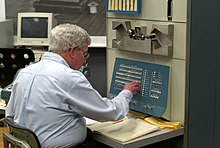PDP-1
The PDP-1 ( P rogrammed D ata P rocessor 1 ) was the first minicomputer and was obtained from DEC (1959 Digital Equipment Corporation develops).
technology
From today's perspective, the term minicomputer seems inappropriate, since the PDP-1 was the size of two refrigerators. In contrast to the much larger IBM machines, this PDP could be started up and controlled by a single person. In addition, it could be used by several people simultaneously. Inquiries made to the PDP were processed and issued immediately - unlike larger computers that ran in batches, where the programs were handed over to the operator as a pile of punched cards and the results were printed out the next day could. The PDP-1 was announced in 1960; the first copy was installed in December 1959.
The PDP-1 was implemented with discrete transistor circuits instead of the electron tubes common at the time . However, integrated circuits have not yet been used.
The developer was the DEC founder Ken Olsen . The direct predecessor was the TX-0 , which was still developed at MIT .
Input devices
- Controls on the device itself (levers and numerous buttons)
- ticker tape
- Light pen
- Telegraph (Teletype) and keyboard (at the same time output device)
Output devices
- round oscilloscope , vector graphic , technically derived from a radar screen ; 12 characters wide. Designation: CRT Type 30, or Type 31 (Ultra Precision)
- Telegraph (Teletype) as the printer
- Punched tape , already according to the standard still widespread today
programming
The computer is supported by the emulators M.ESS and SIMH . There are also numerous space wars! -Simulations.
The computer was programmed in assembly language or in LISP . In contrast to today's computers, the memory was not addressed in octets , but in 18-bit words . The main memory in the basic version consisted of 4096 of these words, which corresponds to 9216 octets .
There are a few basic commands. Most of the others concern the output devices.
Basic commands with the appropriate code
- ADD Y (40) ADD C (Y) to C (AC)
- AND Y (02) logical AND C (Y) with C (AC)
- CAL Y (16) JDA 100
- DAC Y (24) Deposit C in Y
- DAP Y (26) Deposit Address part AC in Y
- DIO Y (32) Deposit C (IO) in Y
- DIP Y (30) Deposits contents AC in Y
- DIV Y (56) Divide
- DZM Y (34) Deposit Zero in Y
- IDX Y (44) Index (add one)
- IOR Y (04) Inclusive OR
- IOT Y (72) In-Output Transfer (many commands, subsequent 2 words required)
- ISP Y (46) Index and Skip
- JDA Y (17) equals DAC Y and JSP Y + 1
- JMP Y (60) next instruction from Y
- JSP Y (62) jump to Y, save program counter in AC
- LAC Y (20) load AC with C (Y)
- LAW N (70) load AC with numer N
- LAW-N (71) load AC with -N
- LIO Y (22) load IO with C (Y)
- MUL Y (54) Multiply
- OPR (76) Operate (9 commands, e.g. 760000 NOP)
- SAD Y (50) skip next instruction if C (AC) <> C (Y)
- SAS Y (52) skip next instruction if C (AC) = C (Y)
- SFT (66) shift, e.g. B. 661 Rotate AC left, 676 Shift IO right
- SKP (64) Skip, e.g. B. 640200 Skip on plus AC
- SUB Y (42) subtract C (Y) from C (AC)
- XCT Y (10) execute instructions in Y
- XOR Y (06) exclusive OR C (Y) with C (AC)
Some examples of other important commands
- RPA (720001) read perforated tape alphanumeric
- RPB (720002) read perforated tape binary
- TYO (720003) type Out
- TYI (720004) type In
- DPY (720007) display one point (CRT Type 30)
- PAC (720043) punch a card (previously: LAG load a group)
classification
The predecessor was the TX-0 (1955/1956), the first computer with transistors. Text-based games were already running on it, e.g. B. Tic-Tac-Toe .
The second model of the PDP-1 became famous because it was given as a gift to the Massachusetts Institute of Technology (MIT) Cambridge and the famous game Spacewar! developed by Steve Russell and other students.
Successors were:



